英语否定句翻译
- 格式:doc
- 大小:31.00 KB
- 文档页数:4
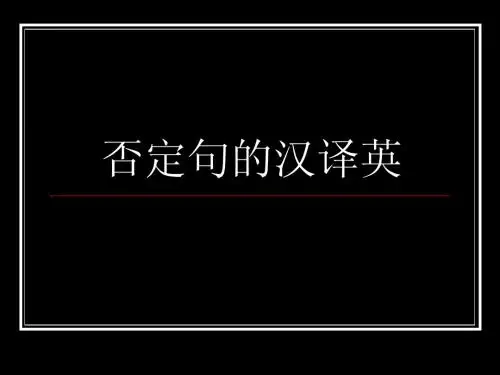
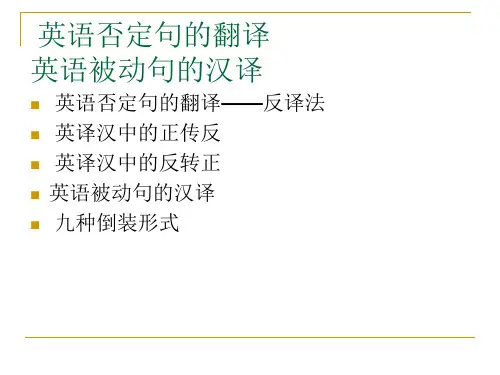

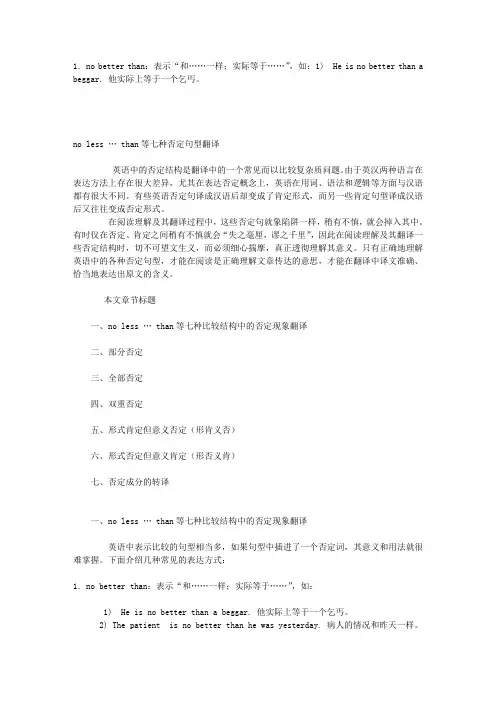
1.no better than:表示“和……一样;实际等于……”,如:1) He is no better than a beggar. 他实际上等于一个乞丐。
no less … than等七种否定句型翻译英语中的否定结构是翻译中的一个常见而以比较复杂质问题。
由于英汉两种语言在表达方法上存在很大差异,尤其在表达否定概念上,英语在用词、语法和逻辑等方面与汉语都有很大不同。
有些英语否定句译成汉语后却变成了肯定形式,而另一些肯定句型译成汉语后又往往变成否定形式。
在阅读理解及其翻译过程中,这些否定句就象陷阱一样,稍有不慎,就会掉入其中。
有时仅在否定、肯定之间稍有不慎就会“失之毫厘,谬之千里”,因此在阅读理解及其翻译一些否定结构时,切不可望文生义,而必须细心揣摩,真正透彻理解其意义。
只有正确地理解英语中的各种否定句型,才能在阅读是正确理解文章传达的意思,才能在翻译中译文准确、恰当地表达出原文的含义。
本文章节标题一、no less … than等七种比较结构中的否定现象翻译二、部分否定三、全部否定四、双重否定五、形式肯定但意义否定(形肯义否)六、形式否定但意义肯定(形否义肯)七、否定成分的转译一、no less … than等七种比较结构中的否定现象翻译英语中表示比较的句型相当多,如果句型中插进了一个否定词,其意义和用法就很难掌握。
下面介绍几种常见的表达方式:1.no better than:表示“和……一样;实际等于……”,如:1) He is no better than a beggar. 他实际上等于一个乞丐。
2) The patient is no better than he was yesterday. 病人的情况和昨天一样。
3) He has no better a say in the matter than I have.他和我一样在这件事上没有发言权。
2.not. . . any more than或no more. . . than:表示“同……一样不”,如:1) I could no more do that than you. I could not do that any more than you. 你不能做这件事,我也不能做。
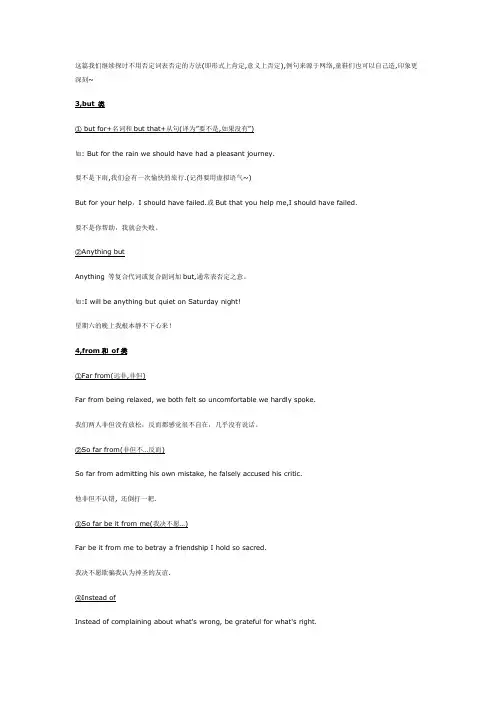
这篇我们继续探讨不用否定词表否定的方法(即形式上肯定,意义上否定),例句来源于网络,童鞋们也可以自己造,印象更深刻~3,but 类① but for+名词和but that+从句(译为”要不是,如果没有”)如: But for the rain we should have had a pleasant journey.要不是下雨,我们会有一次愉快的旅行.(记得要用虚拟语气~)But for your help,I should have failed.或But that you help me,I should have failed.要不是你帮助,我就会失败。
②Anything butAnything 等复合代词或复合副词加but,通常表否定之意。
如:I will be anything but quiet on Saturday night!星期六的晚上我根本静不下心来!4,from和of类①Far from(远非,非但)Far from being relaxed, we both felt so uncomfortable we hardly spoke.我们两人非但没有放松,反而都感觉很不自在,几乎没有说话。
②So far from(非但不…反而)So far from admitting his own mistake, he falsely accused his critic.他非但不认错, 还倒打一耙.③So far be it from me(我决不愿…)Far be it from me to betray a friendship I hold so sacred.我决不愿欺骗我认为神圣的友谊.④Instead ofInstead of complaining about what's wrong, be grateful for what's right.别抱怨不好的事,要对好的事心存感恩。
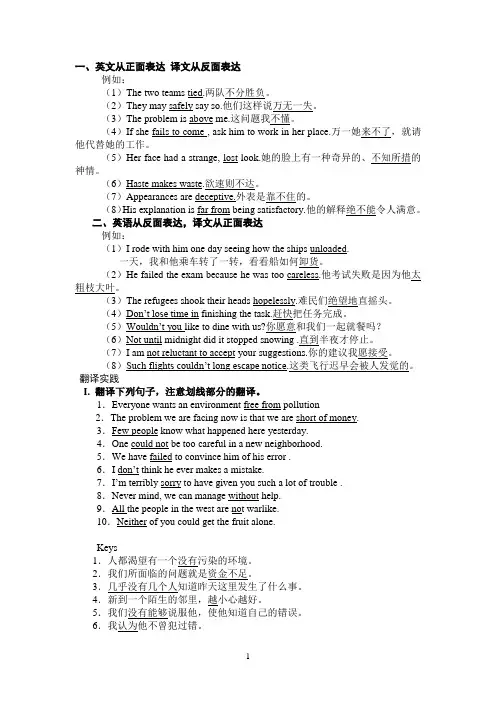
一、英文从正面表达译文从反面表达例如:(1)The two teams tied.两队不分胜负。
(2)They may safely say so.他们这样说万无一失。
(3)The problem is above me.这问题我不懂。
(4)If she fails to come , ask him to work in her place.万一她来不了,就请他代替她的工作。
(5)Her face had a strange, lost look.她的脸上有一种奇异的、不知所措的神情。
(6)Haste makes waste.欲速则不达。
(7)Appearances are deceptive.外表是靠不住的。
(8)His explanation is far from being satisfactory.他的解释绝不能令人满意。
二、英语从反面表达,译文从正面表达例如:(1)I rode with him one day seeing how the ships unloaded.一天,我和他乘车转了一转,看看船如何卸货。
(2)He failed the exam because he was too careless.他考试失败是因为他太粗枝大叶。
(3)The refugees shook their heads hopelessly.难民们绝望地直摇头。
(4)Don’t lose time in finishing the task.赶快把任务完成。
(5)Wouldn’t you like to dine with us?你愿意和我们一起就餐吗?(6)Not until midnight did it stopped snowing .直到半夜才停止。
(7)I am not reluctant to accept your suggestions.你的建议我愿接受。
(8)Such flights couldn’t long escape notice.这类飞行迟早会被人发觉的。
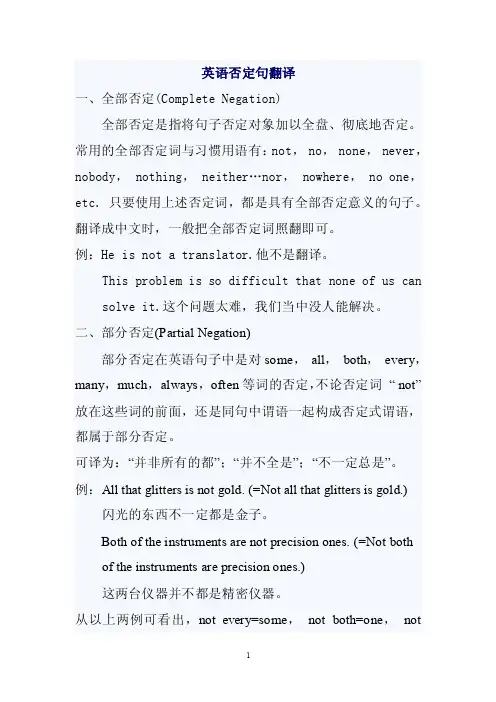
英语否定句翻译一、全部否定(Complete Negation)全部否定是指将句子否定对象加以全盘、彻底地否定。
常用的全部否定词与习惯用语有:not, no, none, never,nobody, nothing,neither…nor, nowhere, no one,etc. 只要使用上述否定词,都是具有全部否定意义的句子。
翻译成中文时,一般把全部否定词照翻即可。
例:He is not a translator.他不是翻译。
This problem is so difficult that none of us can solve it.这个问题太难,我们当中没人能解决。
二、部分否定(Partial Negation)部分否定在英语句子中是对some,all,both,every,many,much,always,often等词的否定,不论否定词“ not”放在这些词的前面,还是同句中谓语一起构成否定式谓语,都属于部分否定。
可译为:“并非所有的都”;“并不全是”;“不一定总是”。
例:All that glitters is not gold. (=Not all that glitters is gold.) 闪光的东西不一定都是金子。
Both of the instruments are not precision ones. (=Not bothof the instruments are precision ones.)这两台仪器并不都是精密仪器。
从以上两例可看出,not every=some,not both=one,notalways=sometimes,not wholly=in some degree not together=somewhat.三、双重否定(Double Negation)双重否定是指两个否定词并用,否定同一个单词,或者一个否定词否定另一个否定词,其否定意义互相抵消得到肯定意义。

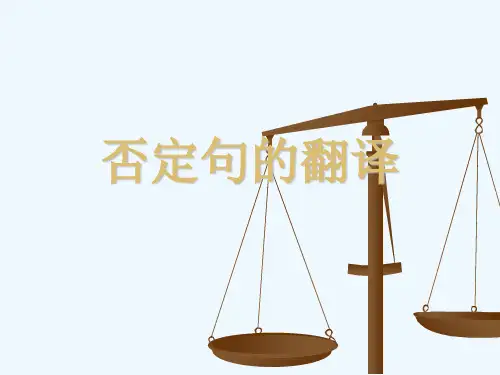

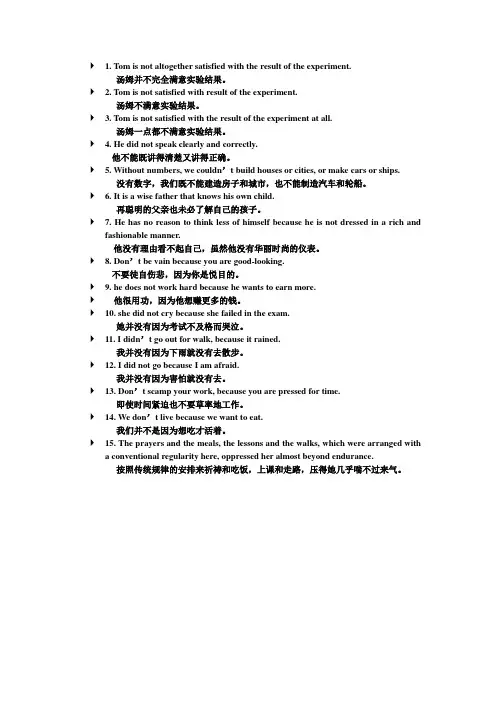
❝ 1. T om is not altogether satisfied with the result of the experiment.汤姆并不完全满意实验结果。
❝ 2. T om is not satisfied with result of the experiment.汤姆不满意实验结果。
❝ 3. T om is not satisfied with the result of the experiment at all.汤姆一点都不满意实验结果。
❝ 4. He did not speak clearly and correctly.他不能既讲得清楚又讲得正确。
❝ 5. Without numbers, we couldn’t build houses or cities, or make cars or ships.没有数字,我们既不能建造房子和城市,也不能制造汽车和轮船。
❝ 6. It is a wise father that knows his own child.再聪明的父亲也未必了解自己的孩子。
❝7. He has no reason to think less of himself because he is not dressed in a rich and fashionable manner.他没有理由看不起自己,虽然他没有华丽时尚的仪表。
❝8. Don’t be vain because you are good-looking.不要徒自伤悲,因为你是悦目的。
❝9. he does not work hard because he wants to earn more.❝他很用功,因为他想赚更多的钱。
❝10. she did not cry because she failed in the exam.她并没有因为考试不及格而哭泣。
❝11. I didn’t go out for walk, because it rained.我并没有因为下雨就没有去散步。
2013-03-26 11:00:14 来源:爱词霸编辑:zhouzhichao 点击:2307次英语否定句及其翻译意思否定的肯定句英语中有许多句子,形式上是肯定的,但是其意思却是否定的,这是因为英语中有许多表示否定意思的词和词组。
首先一类是所谓“准否定词,包括few, little, hardly, rarely, scarcely, barely, seldom:Few people have ever seen him get out of that house. 几乎没什么人看见他从那间屋子里出来过。
He has seen little of life.。
他不懂什么世故(没有见过什么世面)。
I can hardly read the original without a dictionary. 不借助于词典我简直看不懂原著。
People rarely see this kind of plant in blossom. 人们很少见到过(几乎没有见到过)这种植物开花。
We scarcely ever need it; take it away.我们极难得需要它(几乎用不着它);把它拿走。
需要注意的是,英语里一般都用这类“准否定词”表示“几乎不”的意思,而不说almost not.其次,英语中有许多动词含有否定的意思。
请看下列例句:The door simply refused to open.门根本就打不开。
The error of calculation escaped the accountant. 会计没有注意到这一计算错误。
He ignored the whole speech of the schoolmaster. 他根本就没有听校长的讲话。
The boy tried by every means to avoid being caught by his father. 那孩子想方设法不让父亲逮住他。
If you had come to my place, I would have told you about it.如果你那时到我这儿来,我是会告诉你的。
(这句话表示事实上的否定,意为“你没有到我这儿来,我也没有告诉你。
”It seemed as if he were trying to teach us all he knew in one class.看起来他好像想把自己所有的知识在一堂课内都教给我们。
(事实上,不可能将所有的知识在一堂课内教授)If only 与过去完成时连用时,表示同过去事实相反的主观设想,同样含有否定的意味,通常翻译成“要是……该多好啊”。
If only you had worked with great care! 你要是更仔细一些该多好啊!If only you had told me before. 要是你早告诉我就好了。
If only he hadn’t driven so fast.他没把车子开得这么快就好了。
8. 介词表示否定英语中介词的使用是相当活跃的,其中有些介词同样表达否定的意义,如from, off, of, in, without, for, above, beyond, past, out of, against, beside, 等等。
He is against the plan. 他反对这个计划。
He is out of work. 他失业了。
Good advice is above/ beyond/ without price. 好的建议是无价的。
This strange idea is beyond belief. 这种奇怪的想法令人难以置信。
I can see nothing without my glasses. 不戴眼镜我什么都看不见。
She is still in two minds. 她还没拿定主意。
I am off duty today. 我今天不值日。
英汉翻译否定句式的翻译l 就词汇而言,英语中表示否定的词比汉语多,按词分类,有名词、代词、动词、形容词、副词、连词等;从意义上分类,有完全否定、部分否定、含蓄否定、双重否定以及其他否定形式等。
就表达方式而言,有用单词或词组表示的,也有用特殊结构表示的。
l 例如,not 和 no 都表示否定,但在否定句中有时候意思却同:l 1. She is not a dancer.l 她不是个舞蹈家。
l 2. She is no dancer.l 她算不上个舞蹈家。
(她跳舞还可以,但还达不到舞蹈家的水平)l 3. It is not easy task.l 这不是一件容易的事。
l 4. It is no easy task.l 这可不是一件轻而易举的事。
(主观上的强调)l 5. It is not a joke.l 这不是玩笑。
l 6. It is no joke.l 这决不是开玩笑的事情。
(着重强调这是件很正经的事)一、完全否定l 英语表示完全否定的词有 no, not, never, none, nobody, nothing, nowhere, neither…nor等。
含有这些词的完全否定句一般情况下意思都是一目了然,只要注意译文的表达,符合现代汉语的习惯就行了。
l None of the answers are right.l 这些答案都不对。
l Matter can neither be created nor be destroyed.l 物质即不能创造又无法消灭。
l He has nothing to do with the matter.l 他和这件事毫无关系。
二、部分否定l 部分否定就是指整个句子所表达的意义或概念不是全部否定,而是既含有部分否定的意思,也含有部分肯定的意思。
部分否定句式常常译为“不都……” “并非……”。
l --所有的问题在会上都没有解决。
l --All of the problems were not solved at meeting. = Not all of the problems were solved …= Some of the problems were solved, but some are not… (错译)l --None of the problems were solved at the meeting.l 注意区分完全否定和部分否定,才能避免翻译上的错误。
英语否定句翻译
一、全部否定(Complete Negation)
全部否定是指将句子否定对象加以全盘、彻底地否定。
常用的全部否定词与习惯用语有:not, no, none, never,nobody, nothing,neither…nor, nowhere, no one,etc. 只要使用上述否定词,都是具有全部否定意义的句子。
翻译成中文时,一般把全部否定词照翻即可。
例:He is not a translator.他不是翻译。
This problem is so difficult that none of us can solve it.这个问题太难,我们当中没人能解决。
二、部分否定(Partial Negation)
部分否定在英语句子中是对some,all,both,every,many,much,always,often等词的否定,不论否定词“ not”放在这些词的前面,还是同句中谓语一起构成否定式谓语,都属于部分否定。
可译为:“并非所有的都”;“并不全是”;“不一定总是”。
例:All that glitters is not gold. (=Not all that glitters is gold.) 闪光的东西不一定都是金子。
Both of the instruments are not precision ones. (=Not both
of the instruments are precision ones.)
这两台仪器并不都是精密仪器。
从以上两例可看出,not every=some,not both=one,not
always=sometimes,not wholly=in some degree not together=somewhat.
三、双重否定(Double Negation)
双重否定是指两个否定词并用,否定同一个单词,或者一个否定词否定另一个否定词,其否定意义互相抵消得到肯定意义。
如果一个句子中同时含有两个否定因素,无论是形式上还是意义上的,可采用两种方法翻译:可译成汉语的双重否定,其语气较强烈;也可以译成肯定。
双重否定句主要有以下三种:
1.全否定词+全否定词英语中的全否定词有:not,no,without,none,nobody,no one,nothing,neit her…nor,nowhere,etc.当这类词出现在同一个句子中时即可构成双重否定句。
例:No one has nothing to offer to society.
人人都可以为社会奉献点什么。
He cannot speak English without making mistakes.
他一说英语就出错。
2.全否定词+半否定词一个全否定词和一个半否定词(little,seldom等)同时出现在一个句子中时,构成双重否定句。
例:Nowadays it is not seldom that a man lives to be seventy years old.如今人活到70岁常见的。
3.全否定词+含有否定意义的词。
如:impatient,unimportant,
impossible,disappeared等。
例:It is impossible for heat to be converted into a certain kind of energy without something lost.
一点不损耗就把热能转换成某种能量是不可能的。
四、含蓄否定(Connotative Negation)
由It be+a+adj+n+that…所引起,译成“不管……也不可能......”例:It is a silly fish that is caught twice.
再蠢的鱼也不会上钩两次。
It is a good goose that is always dropping.
世间没有连续下蛋的鹅。
(劝人不要过多地向朋友讨东西。
)
It is a wise man that makes no mistake.
任何人都难免要犯错误。
或:智者千虑,必有一失。
It is a good fisherman that catches fish all time.
再好的渔夫也不会时时捕到鱼。
It is a good horse that never stumbles.
再好的马也会失蹄。
It is a long lane that has no turning.
无论怎样长的巷子都不免有转弯的地方。
但这并不意味着所有的“It be+a+adj+n+that…”结构,一律都要按“无论怎样…都不免…”或“无论怎样…都未必…”等规则来翻译。
根据一些资料来看,无论在古体英语中或在现代英语中,“It be+a+adj+n+that…”结构,按一
般强调结构来理解并翻译的例子也不少,也就是说,这种结构的真正含义与字面上的完全一致。
例:
It is a foolish sheep that makes the wolf his confessor. 是蠢羊才向狼忏悔。